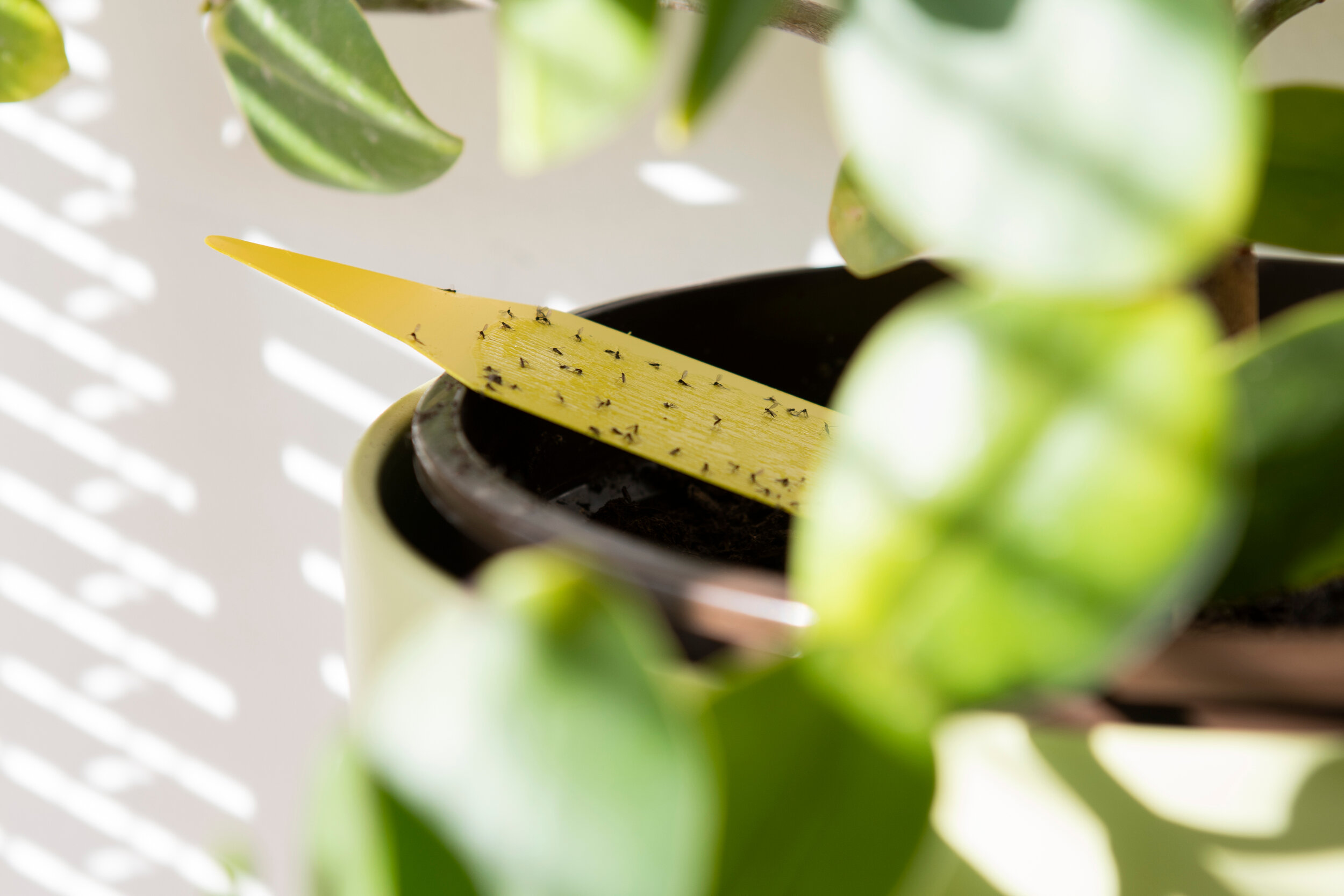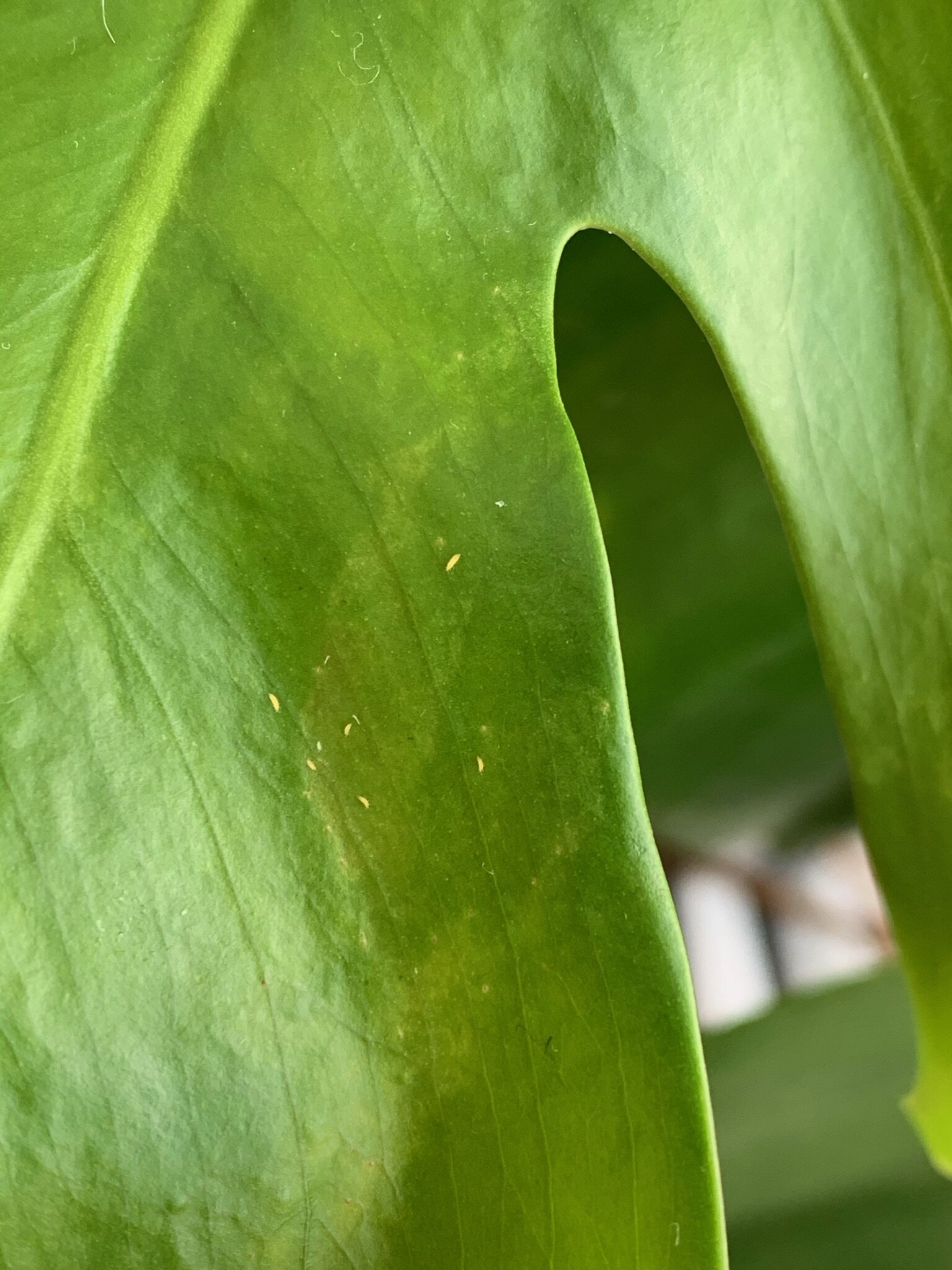Even the most doting of houseplant lovers is unfortunately likely to experience pests on their beloved collection at some point, so here is a rundown of the most common houseplant pests with tried and tested treatments.
Fungus gnats
These are probably the most common houseplant pest. They are small dark coloured flies, often confused with fruit flies which are slightly lighter brown in colour. The gnats are drawn to damp conditions and have a larvae stage which live in the soil.
Fungus gnats on yellow sticky trap
Fungus gnat damage
The gnats themselves do little damage but are an annoyance. The larvae can attack the fine roots of plants eventually causing the plant to weaken and causing yellowing leaves.
Fungus gnat treatment
There are a number of methods to try listed below, either in conjunction with each other or independent from each other. All are natural and many require just a few items you will likely have at home.
Repot the plant in new soil with the aim of removing larvae.
Add a good layer of cinnamon to the soil which acts as a natural fungicide killing the fungus that the larvae feed on.
Place a cup of beer or apple cider vinegar mixed with a few drops of washing up liquid next to the plants to attract and then drown the gnats.
Cover the soil with a grit, sand or small pebbles. We love Shell On Earth’s crushed whelk shells for this.
Place yellow sticky traps around the plant to attract and kill the gnats.
Food grade diatomaceous earth (DE) can be sprinkled in a layer on top of soil or mixed into soil. This is a powder made from crushed water fossils containing silica which kills the larvae. Be careful not to breath it in when using.
Place a carnivorous plant such as Pinguicula (Butterwort) next to the affected plants to attract and kill the gnats.
Introduce a Nematode (a living organism that is a natural predator). Fungus gnat nematodes should be mixed with water and applied to the affected plants as per suppliers instructions. The nematodes will kill the larvae of the fungus gnats.
Fungus gnat prevention
Always water from the bottom of the plant to avoid over watering and to prevent the soil from being damp for extended periods. Allow the top of the soil to dry out between waterings.
Mealy bugs
The much maligned mealy bugs are often brought into the house from an infected plant. They do not travel far so strict quarantining of affected plants along with the treatment methods below can be really successful.
Mealy bug damage
The bugs are visible to the eye, appearing as white fluff. They are often found in flowers, stem joints and leaves. They suck the plant’s sap and the excrement produced is a sticky substance called honeydew which becomes mouldy. Sucking of sap weakens the plant and in long-term infestations the leaves will become yellow, eventually drop off and the plant can die.
Mealy bug treatment
Apply neat rubbing alcohol onto the mealy bugs and the nooks and crannies of the plant using a paint brush or cotton bud. Spray the whole plant with a mix of 0.25ml neem oil, 5-10ml rubbing alcohol into 0.5 litres of water. Please note, there is some evidence that neem oil can ‘burn’ the leaves of plants, however in a small diluted quantity we and many other houseplant lovers have not experienced this. Keep the plant away from other healthy plants.
SB Invigorator is another option for the control of mealy bugs. It is non-toxic and chemical free, it can be used when mealy bugs are spotted on the plant and also as a preventative measure.
Nematodes: you can introduce Cryptolaemus Larvae when mealy bugs are first spotted. Place the larvae directly onto the infected plants near the mealy bugs - these larvae are easy to handle. The larvae (which look very similar to mealy bugs) feed on the mealy bug before turning into the adult ladybirds.
Mealy bug prevention
Carry out regular checks on your plants for pests and signs of damage. Check plants carefully for bugs before purchase and consider quarantining new purchases for extra safety. Spray weekly with a mix of 0.25ml neem oil, 0.25ml washing up liquid mixed in 0.5 litres of water, or use SB invigorator according to instructions as a preventative measure.
Thrips
Thrips are known for being one of the trickiest blighters to eradicate and are easily spread from one plant to another. The adult thrips are 1-2mm long winged insects (thunderflies) however you may also spot the wingless larvae which are light yellow in colour. Persistance is key to battling these, although many people will turn to a chemical such as Resolva or Provanto for eradicating an infestation.
Thrip nymphs and mottled thrip damage
Thrip damage
Thrips feed by sucking sap which causes a discolouration on the upper side of the leaf, which can often appear as silvery streaks. You may also spot small brown specks which are excrement. The sucking of sap will eventually weaken the plant. Damage to new shoots can cause distorted growth.
Thrip treatment
Remove any heavily infected areas of the plant, then hose the plant to wash away as many of the pests as possible (try not to let the water run into the soil at the base of the plant) and apply a pesticide such as SB invigorator or 0.25 ml neem oil, 5-10ml alcohol in 0.5 litres of water, which can be sprayed all over the plant. This process will likely have to be repeated on a weekly basis over the next few weeks to eradicate the pests. Keep infested plants away from healthy plants.
Nematodes: Thrip nematodes are bought as a powder which is mixed with water and applied with a sprayer, according to supplier instructions.
Thrip prevention
Carry out regular checks on your plants for bugs. New plants can be quarantined for extra safety. Spray plants weekly with a mix of 0.25 ml neem oil, 0.25 ml washing up liquid and 0.5 litres of water, or use SB invigorator according to instructions as a preventative measure.
Spider Mites
These are minuscule spiders whose damage can eventually kill a plant. They can be tricky to spot until an infestation is serious so it is worth keeping a close eye on your plants and looking out for tell-tale signs. It’s worth noting that Calathea are particularly prone to spider mites.
Spider mite infestation on plant. Webbing and mites visible.
Spider mite damage
Spider mite damage will appear as yellow or brown mottling on the upper side of a leaf, caused by piercing of the underside of the leaf in order for the pests to suck the sap. In heavily infested plants you will spot webs and the mites themselves. Serious infestations can cause leaves to drop and the plant to die.
Spider mite treatment
Remove any heavily infected areas of the plant. Hose or wipe the plant to remove as many of the pests as possible and then apply a pesticide such as SB invigorator or 0.25 ml neem oil, 5-10 ml rubbing alcohol, and 0.5 litres of water, which can be sprayed all over plant. You may need to repeat this process weekly until the pests and damage are no longer apparent.
Nematodes: A natural predator, Phytoseiulus can be introduced as soon as you see the mites. These are mites themselves, smaller than spider mites but can feed on all lifecycle stages of spider mites. They come in a tube and can be sprinkled over the infected plant.
Spider mite prevention
Carry out regular checks on your plants for bugs. New plants can be quarantined for extra safety. Spray plants weekly with a mix of 0.25 ml neem oil, 0.25 ml washing up liquid and 0.5 litres of water, or use SB invigorator according to instructions as a preventative measure.
Springtails
It is slightly unfair to have Springtails mentioned in a blog about pests as they actually cause no harm to our houseplants at all. However they are often mistaken for something more damaging so it is useful to be able to identify them.
Springtails crawling on just watered soil
Springtail identification
Springtails are small wingless, 6 legged creatures. They grow up to 6mm and are able to jump when disturbed. They are no longer classed as insects and are instead known as Hexapods.
You are likely to spot Springtails crawling around on top of soil once you have watered, or in the soil when you are repotting.
Springtails live in soil and feed on decaying vegetation and microbes, hence why they don’t cause damage to our houseplants - lucky for us they don’t feed on living vegetation.
Springtail prevention
Although they don’t cause damage to plants, Springtails can be hugely abundant in nature in which case you may want to think about ways to limit them in your plants.
Springtails thrive in a damp environment so they are less likely to be found in soil that is allowed to dry out between waterings. They are also less likely to be present in plants such as cacti and succulents and tropical houseplants that are not overwatered.
We hope this has been of use.
Do have a browse of our other blog articles for tips, advice and insights from industry experts.





